2007 GMC SIERRA CLASSIC steering
[x] Cancel search: steeringPage 564 of 674
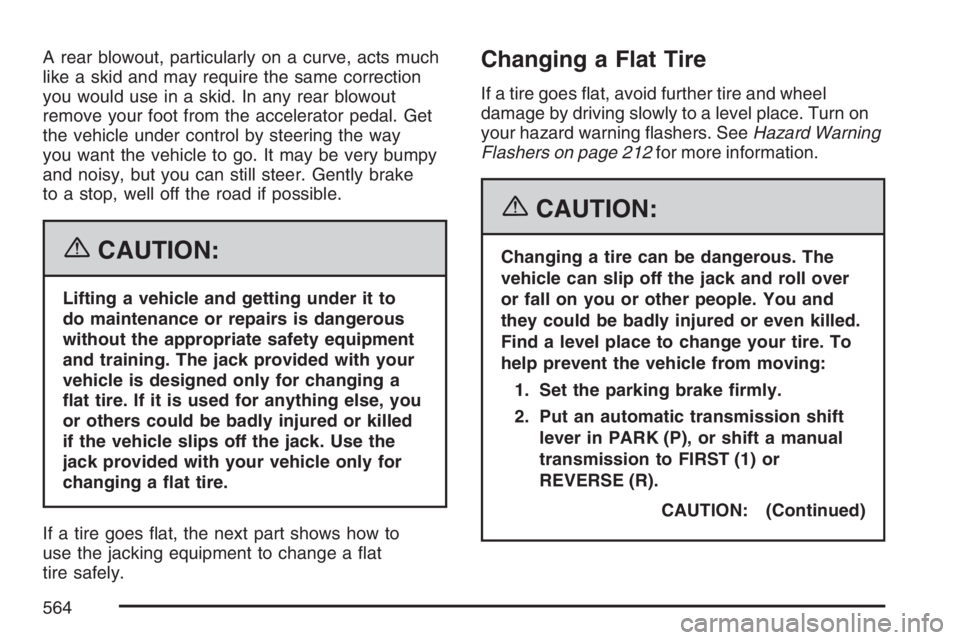
A rear blowout, particularly on a curve, acts much
like a skid and may require the same correction
you would use in a skid. In any rear blowout
remove your foot from the accelerator pedal. Get
the vehicle under control by steering the way
you want the vehicle to go. It may be very bumpy
and noisy, but you can still steer. Gently brake
to a stop, well off the road if possible.
{CAUTION:
Lifting a vehicle and getting under it to
do maintenance or repairs is dangerous
without the appropriate safety equipment
and training. The jack provided with your
vehicle is designed only for changing a
�at tire. If it is used for anything else, you
or others could be badly injured or killed
if the vehicle slips off the jack. Use the
jack provided with your vehicle only for
changing a �at tire.
If a tire goes �at, the next part shows how to
use the jacking equipment to change a �at
tire safely.
Changing a Flat Tire
If a tire goes �at, avoid further tire and wheel
damage by driving slowly to a level place. Turn on
your hazard warning �ashers. SeeHazard Warning
Flashers on page 212for more information.
{CAUTION:
Changing a tire can be dangerous. The
vehicle can slip off the jack and roll over
or fall on you or other people. You and
they could be badly injured or even killed.
Find a level place to change your tire. To
help prevent the vehicle from moving:
1. Set the parking brake �rmly.
2. Put an automatic transmission shift
lever in PARK (P), or shift a manual
transmission to FIRST (1) or
REVERSE (R).
CAUTION: (Continued)
564
Page 602 of 674
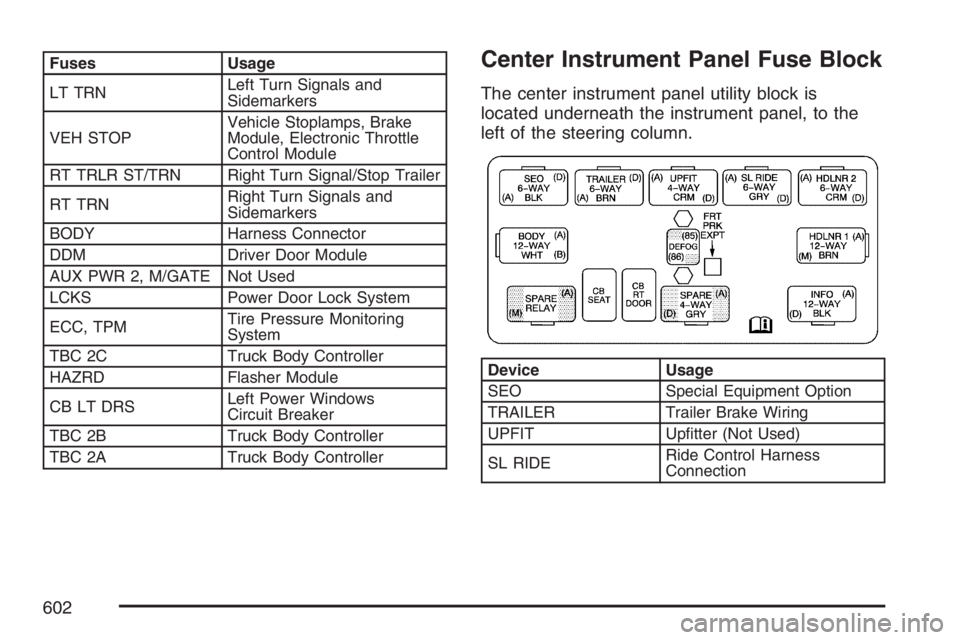
Fuses Usage
LT TRNLeft Turn Signals and
Sidemarkers
VEH STOPVehicle Stoplamps, Brake
Module, Electronic Throttle
Control Module
RT TRLR ST/TRN Right Turn Signal/Stop Trailer
RT TRNRight Turn Signals and
Sidemarkers
BODY Harness Connector
DDM Driver Door Module
AUX PWR 2, M/GATE Not Used
LCKS Power Door Lock System
ECC, TPMTire Pressure Monitoring
System
TBC 2C Truck Body Controller
HAZRD Flasher Module
CB LT DRSLeft Power Windows
Circuit Breaker
TBC 2B Truck Body Controller
TBC 2A Truck Body ControllerCenter Instrument Panel Fuse Block
The center instrument panel utility block is
located underneath the instrument panel, to the
left of the steering column.
Device Usage
SEO Special Equipment Option
TRAILER Trailer Brake Wiring
UPFIT Up�tter (Not Used)
SL RIDERide Control Harness
Connection
602
Page 620 of 674
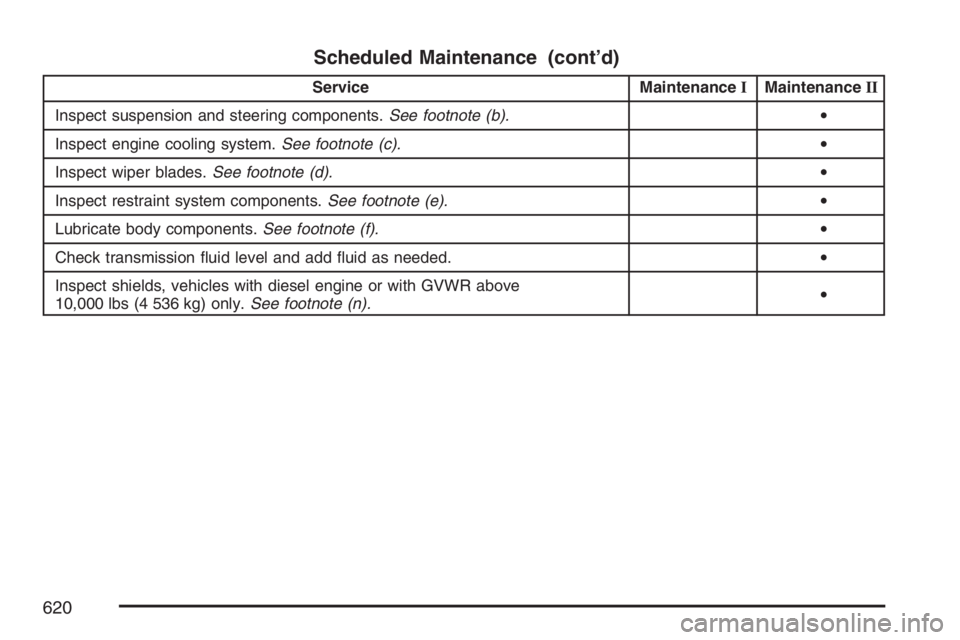
Scheduled Maintenance (cont’d)
Service MaintenanceIMaintenanceII
Inspect suspension and steering components.See footnote (b).•
Inspect engine cooling system.See footnote (c).•
Inspect wiper blades.See footnote (d).•
Inspect restraint system components.See footnote (e).•
Lubricate body components.See footnote (f).•
Check transmission �uid level and add �uid as needed.•
Inspect shields, vehicles with diesel engine or with GVWR above
10,000 lbs (4 536 kg) only.See footnote (n).•
620
Page 623 of 674
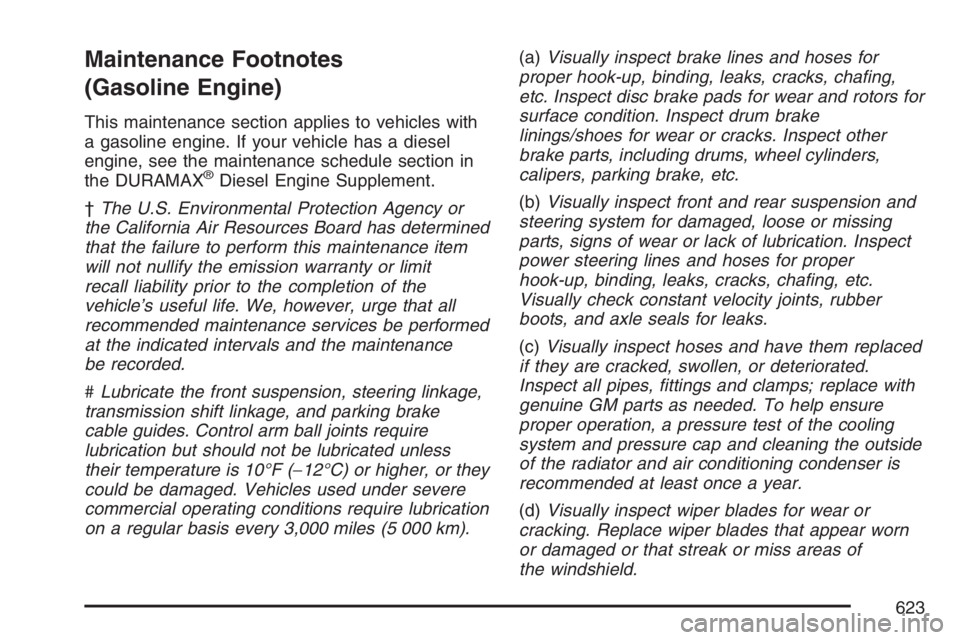
Maintenance Footnotes
(Gasoline Engine)
This maintenance section applies to vehicles with
a gasoline engine. If your vehicle has a diesel
engine, see the maintenance schedule section in
the DURAMAX
®Diesel Engine Supplement.
†The U.S. Environmental Protection Agency or
the California Air Resources Board has determined
that the failure to perform this maintenance item
will not nullify the emission warranty or limit
recall liability prior to the completion of the
vehicle’s useful life. We, however, urge that all
recommended maintenance services be performed
at the indicated intervals and the maintenance
be recorded.
#Lubricate the front suspension, steering linkage,
transmission shift linkage, and parking brake
cable guides. Control arm ball joints require
lubrication but should not be lubricated unless
their temperature is 10°F (−12°C) or higher, or they
could be damaged. Vehicles used under severe
commercial operating conditions require lubrication
on a regular basis every 3,000 miles (5 000 km).(a)Visually inspect brake lines and hoses for
proper hook-up, binding, leaks, cracks, cha�ng,
etc. Inspect disc brake pads for wear and rotors for
surface condition. Inspect drum brake
linings/shoes for wear or cracks. Inspect other
brake parts, including drums, wheel cylinders,
calipers, parking brake, etc.
(b)Visually inspect front and rear suspension and
steering system for damaged, loose or missing
parts, signs of wear or lack of lubrication. Inspect
power steering lines and hoses for proper
hook-up, binding, leaks, cracks, cha�ng, etc.
Visually check constant velocity joints, rubber
boots, and axle seals for leaks.
(c)Visually inspect hoses and have them replaced
if they are cracked, swollen, or deteriorated.
Inspect all pipes, �ttings and clamps; replace with
genuine GM parts as needed. To help ensure
proper operation, a pressure test of the cooling
system and pressure cap and cleaning the outside
of the radiator and air conditioning condenser is
recommended at least once a year.
(d)Visually inspect wiper blades for wear or
cracking. Replace wiper blades that appear worn
or damaged or that streak or miss areas of
the windshield.
623
Page 630 of 674
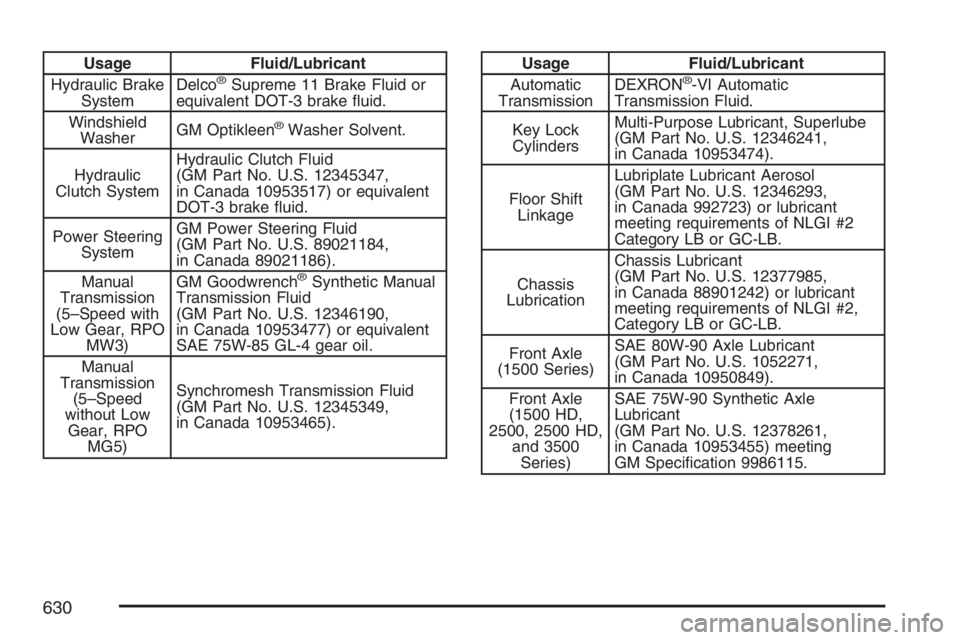
Usage Fluid/Lubricant
Hydraulic Brake
SystemDelco®Supreme 11 Brake Fluid or
equivalent DOT-3 brake �uid.
Windshield
WasherGM Optikleen
®Washer Solvent.
Hydraulic
Clutch SystemHydraulic Clutch Fluid
(GM Part No. U.S. 12345347,
in Canada 10953517) or equivalent
DOT-3 brake �uid.
Power Steering
SystemGM Power Steering Fluid
(GM Part No. U.S. 89021184,
in Canada 89021186).
Manual
Transmission
(5–Speed with
Low Gear, RPO
MW3)GM Goodwrench
®Synthetic Manual
Transmission Fluid
(GM Part No. U.S. 12346190,
in Canada 10953477) or equivalent
SAE 75W-85 GL-4 gear oil.
Manual
Transmission
(5–Speed
without Low
Gear, RPO
MG5)Synchromesh Transmission Fluid
(GM Part No. U.S. 12345349,
in Canada 10953465).
Usage Fluid/Lubricant
Automatic
TransmissionDEXRON®-VI Automatic
Transmission Fluid.
Key Lock
CylindersMulti-Purpose Lubricant, Superlube
(GM Part No. U.S. 12346241,
in Canada 10953474).
Floor Shift
LinkageLubriplate Lubricant Aerosol
(GM Part No. U.S. 12346293,
in Canada 992723) or lubricant
meeting requirements of NLGI #2
Category LB or GC-LB.
Chassis
LubricationChassis Lubricant
(GM Part No. U.S. 12377985,
in Canada 88901242) or lubricant
meeting requirements of NLGI #2,
Category LB or GC-LB.
Front Axle
(1500 Series)SAE 80W-90 Axle Lubricant
(GM Part No. U.S. 1052271,
in Canada 10950849).
Front Axle
(1500 HD,
2500, 2500 HD,
and 3500
Series)SAE 75W-90 Synthetic Axle
Lubricant
(GM Part No. U.S. 12378261,
in Canada 10953455) meeting
GM Speci�cation 9986115.
630
Page 657 of 674
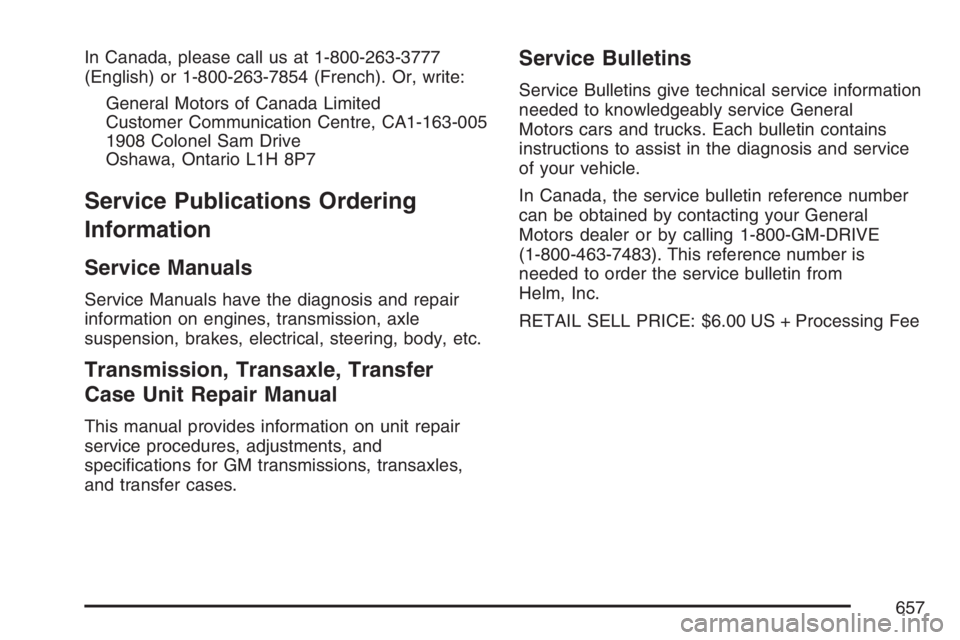
In Canada, please call us at 1-800-263-3777
(English) or 1-800-263-7854 (French). Or, write:
General Motors of Canada Limited
Customer Communication Centre, CA1-163-005
1908 Colonel Sam Drive
Oshawa, Ontario L1H 8P7
Service Publications Ordering
Information
Service Manuals
Service Manuals have the diagnosis and repair
information on engines, transmission, axle
suspension, brakes, electrical, steering, body, etc.
Transmission, Transaxle, Transfer
Case Unit Repair Manual
This manual provides information on unit repair
service procedures, adjustments, and
speci�cations for GM transmissions, transaxles,
and transfer cases.
Service Bulletins
Service Bulletins give technical service information
needed to knowledgeably service General
Motors cars and trucks. Each bulletin contains
instructions to assist in the diagnosis and service
of your vehicle.
In Canada, the service bulletin reference number
can be obtained by contacting your General
Motors dealer or by calling 1-800-GM-DRIVE
(1-800-463-7483). This reference number is
needed to order the service bulletin from
Helm, Inc.
RETAIL SELL PRICE: $6.00 US + Processing Fee
657
Page 660 of 674
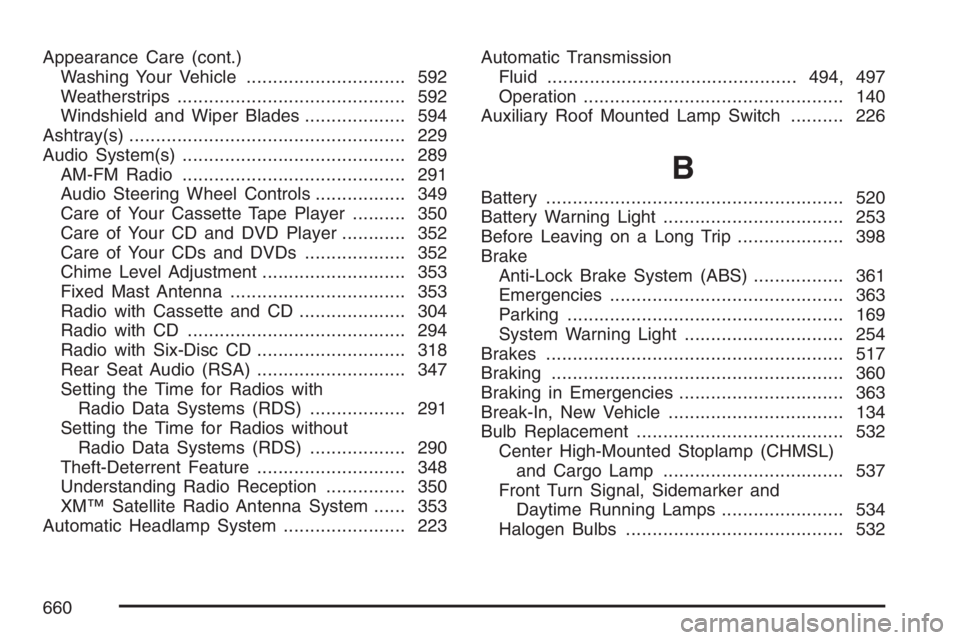
Appearance Care (cont.)
Washing Your Vehicle.............................. 592
Weatherstrips........................................... 592
Windshield and Wiper Blades................... 594
Ashtray(s).................................................... 229
Audio System(s).......................................... 289
AM-FM Radio.......................................... 291
Audio Steering Wheel Controls................. 349
Care of Your Cassette Tape Player.......... 350
Care of Your CD and DVD Player............ 352
Care of Your CDs and DVDs................... 352
Chime Level Adjustment........................... 353
Fixed Mast Antenna................................. 353
Radio with Cassette and CD.................... 304
Radio with CD......................................... 294
Radio with Six-Disc CD............................ 318
Rear Seat Audio (RSA)............................ 347
Setting the Time for Radios with
Radio Data Systems (RDS).................. 291
Setting the Time for Radios without
Radio Data Systems (RDS).................. 290
Theft-Deterrent Feature............................ 348
Understanding Radio Reception............... 350
XM™ Satellite Radio Antenna System...... 353
Automatic Headlamp System....................... 223Automatic Transmission
Fluid...............................................494, 497
Operation................................................. 140
Auxiliary Roof Mounted Lamp Switch.......... 226
B
Battery........................................................ 520
Battery Warning Light.................................. 253
Before Leaving on a Long Trip.................... 398
Brake
Anti-Lock Brake System (ABS)................. 361
Emergencies............................................ 363
Parking.................................................... 169
System Warning Light.............................. 254
Brakes........................................................ 517
Braking....................................................... 360
Braking in Emergencies............................... 363
Break-In, New Vehicle................................. 134
Bulb Replacement....................................... 532
Center High-Mounted Stoplamp (CHMSL)
and Cargo Lamp.................................. 537
Front Turn Signal, Sidemarker and
Daytime Running Lamps....................... 534
Halogen Bulbs......................................... 532
660
Page 664 of 674
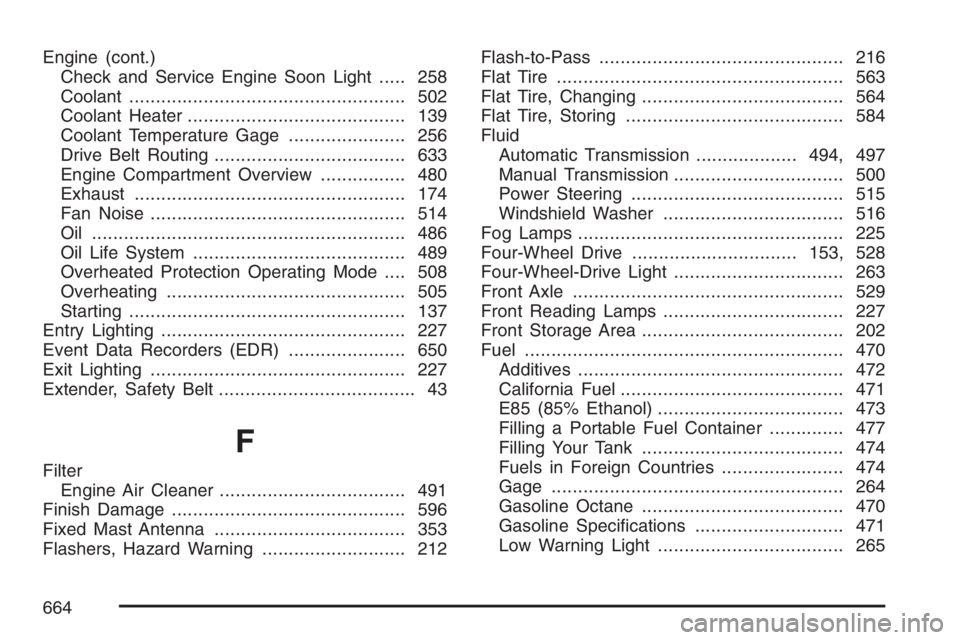
Engine (cont.)
Check and Service Engine Soon Light..... 258
Coolant.................................................... 502
Coolant Heater......................................... 139
Coolant Temperature Gage...................... 256
Drive Belt Routing.................................... 633
Engine Compartment Overview................ 480
Exhaust................................................... 174
Fan Noise................................................ 514
Oil ........................................................... 486
Oil Life System........................................ 489
Overheated Protection Operating Mode.... 508
Overheating............................................. 505
Starting.................................................... 137
Entry Lighting.............................................. 227
Event Data Recorders (EDR)...................... 650
Exit Lighting................................................ 227
Extender, Safety Belt..................................... 43
F
Filter
Engine Air Cleaner................................... 491
Finish Damage............................................ 596
Fixed Mast Antenna.................................... 353
Flashers, Hazard Warning........................... 212Flash-to-Pass.............................................. 216
Flat Tire...................................................... 563
Flat Tire, Changing...................................... 564
Flat Tire, Storing......................................... 584
Fluid
Automatic Transmission...................494, 497
Manual Transmission................................ 500
Power Steering........................................ 515
Windshield Washer.................................. 516
Fog Lamps.................................................. 225
Four-Wheel Drive...............................153, 528
Four-Wheel-Drive Light................................ 263
Front Axle................................................... 529
Front Reading Lamps.................................. 227
Front Storage Area...................................... 202
Fuel............................................................ 470
Additives.................................................. 472
California Fuel.......................................... 471
E85 (85% Ethanol)................................... 473
Filling a Portable Fuel Container.............. 477
Filling Your Tank...................................... 474
Fuels in Foreign Countries....................... 474
Gage....................................................... 264
Gasoline Octane...................................... 470
Gasoline Speci�cations............................ 471
Low Warning Light................................... 265
664